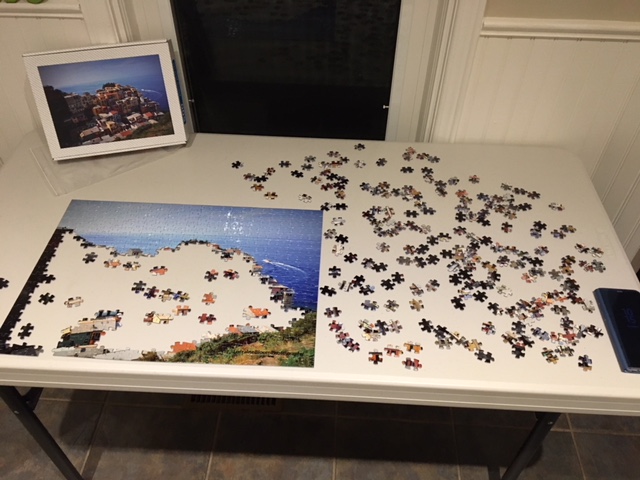Going public with my puzzle
21 December 2017I don’t like doing jig-saw puzzles and other games that come in a box. They Boggle my mind, Scrabble my brain. I prefer puzzles beyond boxes, including the box called “thinking outside the box.”
Recently, I joined some family in Toronto for a game that I was told I would love, as soon as I figured it out. I never did figure it out, perhaps because I never cared to figure it out. Look, I’m a word guy who goes blank in cross-word puzzles (although I delight in inventing words, like TWOG).
On a table, beside this game of ours, sat a jig-saw puzzle, its pieces strewn about near the box that showed what picture to make. Then and there it hit me. These games are too pat for me, too circumscribed, closed-ended. Choose the proper words or move the proper pieces while respecting the proper rules to make the proper picture. I want to fly with ideas, not be grounded by some rules.
So let’s call these pat puzzles, to compare them with another kind of puzzle, defined in my dictionary as “a difficult or confusing problem.” These we can call puzzling puzzles. They are not about breaking the rules so much as creating new rules to get around old rules that are broken. To do this, we have to be playful rather than pat. Puzzling puzzles require solutions that are outrageous—until they turn out to be obvious.
In a pat puzzle (jig-saw):
1. The pieces are supplied.
2. Each is clean-cut.
3. They fit together perfectly
4. To make the picture shown on the box.

(I took this photo of that table in Toronto.)
In a puzzling puzzle
1. The pieces have to be discovered, or created.
2. Each appears obscure, like a fragment.
3. They need to connect, although never neatly.
4. With no box in sight, the picture has to be constructed from these fragments and connections.

(I took this photo of my work table at home, exactly as I had left it earlier, while puzzling over this TWOG. Notice the fragments at the front, loosely connected.)
Pat solutions for puzzling problems?
Why are we so enamored with puzzles that are pat. Sure they can be fun, even useful for problems that are pat. But how about problems that are not? Pat solutions can no more resolve puzzling puzzles than can Monopoly develop entrepreneurs or chess model guerrilla warfare.
We used to play more open-ended puzzles at home. Remember charades—that was playful. And how about LEGO? It used to let the kids build their own thing, instead of assembling 3-dimentional jig-saw puzzles. Here in Canada, kids used to learn hockey on some local pond. Now they are marched off to a designated arena where a designated coach teaches them the designated way to play. No wonder novelty has declined in professional hockey.
As for adults, look at how much of medicine, management, politics, and life has succumbed to pat programming. Get the patient or the problem into a category, a box where clean-cut pieces can be connected correctly. As a physician, diagnose that disease to apply the proper protocols. As a captain of industry, buy and sell businesses the way you bought and sold Monopoly hotels. In the affairs of state, treat diplomacy like a game of chess. And in life, find a partner on a dating site that lists categories of compatibility.
Some of this is fine when an existing category fits. Hail to those protocols and marriages that work. But problems fester when there is a misfit, or a forced fit, or no fit. A patient falls between the cracks of medical specialties. A merger or marriage proves incompatible beyond the categories. Diplomacy discovers that chess isn’t much of a model when faced with guerrila warfare.
Why do we have this propensity to use pat programming for puzzling problems? Sure, it’s easier. But just as surely, it’s fruitless. Has pat schooling killed our capacity for discovery? Or is it all those convenient apps we use on our phones? Click and go—no novelty required. (Siri does the thinking.) Do we play too many games that come in e and cardboard boxes, or watch too many sitcoms on that big black box? Maybe we have simply become irrationally rational, thanks to centuries of privileging thinking over seeing and doing.
Our profound puzzle
Now we face a number of particularly difficult and confusing problems—puzzling puzzles that are foreboding, yet continue to fester. These include global warming, income disparities, and declining democracy. I see them as the fragments of a single profound puzzle, which in various TWOGs and a book I attribute to a basic imbalance in society. Narrow economic forces, encouraged by rampant individualism and unrestrained globalization, have been overwhelming our collective and communal needs as human beings.
What can we do about this imbalance? We can start by putting seeing and doing ahead of thinking. We need a compelling image of what we are facing that can suggest concerted action, so that we can begin to think differently. This is the puzzle that engages me now: how to form that image—a comprehensive picture to see our way to a rebalanced society.
As I probe around—by meeting, reading, testing, tweeting—the fragments of ideas come at me, left and right, in no particular order. (I list some below—in a box of all things!) Imagine the image I am trying to construct as a map on which the fragments can be positioned and connected, to locate ourselves in the territory and construct possible routes to a better place.
Each new fragment contributes to the image that is forming in my mind. So please stay connected as I post the play of this profound puzzle.
___________________________________________________________________
Some fragments for rebalancing society
Some of these fragments have been mentioned in TWOGs, as indicated; others are ideas in progress.
• Focusing corporate social responsibility on the causes of problems, not just their conditions (CSR 2.0)
• Liberating enterprises from the tyranny of the stock market
• Shifting production and consumption away from MORE, toward better
• Encouraging Indigenous development from the inside up
• Putting economic globalization in its place, namely the marketplace (forthcoming)
• Challenging illegitimate trade tribunals in national courts
• Building up the social economy
• Using progressive protests (1 hour longer each day) for impact
• Collaborating among prominent NGOs for common cause, beyond institutional causes
• Establishing a Peace Council (see pp. 92-93) for security instead of insecurity
• Developing a worldly strategy for the global climate (with Dror Etzion and Saku Mantere, submitted for publication)
___________________________________________________________________
This last one may be the start of a map, with key roles of the three sectors located around a circle: grounded engagement in the plural sector, autonomous venturing in the private sector, and orchestrated planning in the public sector. The fragments listed above can be placed near each, but we conclude that real progress will depend, not on a collection of such efforts, but a consolidation of them around the circle.
© Henry Mintzberg 2017. My thanks to Dulcie and the gang, Dulcie for the idea of the map, Gavin and Lorraine for the puzzles, and David for explaining why there may now be less novelty in professional hockey.
Follow this TWOG on Twitter @mintzberg141, or receive the blogs directly in your inbox by subscribing here. To help disseminate these blogs, we also have a Facebook page and a LinkedIn page.